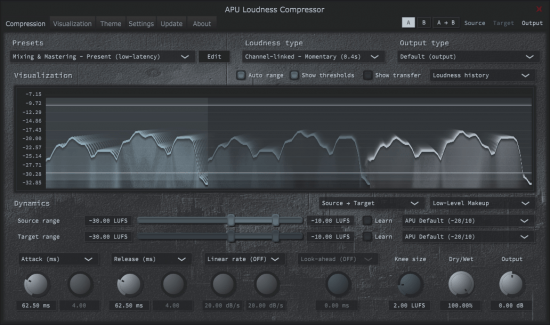
APU 响度压缩器是一款专为支持现代响度类型(LUFS、真实峰值)而设计的压缩器/扩展器。这意味着压缩曲线是 LUFS 测量值的函数,而不是有效值或峰值的函数。由于 LUFS 是一种更精确的响度测量方法,因此压缩效果非常透明,特别适合母带处理和后期制作工作流程。压缩器还能以更传统的方式运行,使用有效值和峰值测量单位,让你既能吃到蛋糕,又能吃到它。
默认情况下,压缩器使用 “源范围 “和 “目标范围 “代替阈值 + 比率控制。如果你喜欢,也可以启用传统的阈值+比率控制。压缩器动态部分右上方的下拉菜单允许在这些操作模式和其他模式(如扩展器、限制器等)之间切换。
启用 “学习 “模式后,压缩器会自动调整源或目标范围,以匹配源材料。这是开始使用压缩器的好方法,也可作为进一步微调的起点。
看看它是否适合你的工作流程。如果您有任何问题或反馈,请随时通过本网站上的 “联系开发者 “信标联系我们。
响度口味
这款压缩器的主要功能之一是支持各种响度类型。压缩器的检测电路可配置为使用 LUFS 或传统测量单位(有效值、峰值)。您还可以选择分割或链接通道,这对多通道音频格式(如 Dolby Atmos®)特别有用。
压缩器的检测电路可配置为使用以下任何响度类型:
瞬间
瞬间是一种短时 LUFS 测量(400 毫秒),适用于处理音频的瞬间动态。这种模式反应灵敏,但也很透明,因此是压缩器的合适默认设置。K 加权和通道加权应用于压缩器的检测电路,提高了感知的准确性。
瞬间 LUFS
Short-Term 是一种持续时间较长的 LUFS 测量模式(3 秒),适用于处理音频的大规模动态。由于持续时间较长,该模式的响应速度不如瞬间模式快,但对于调整音频动态的全貌很有帮助。与瞬间模式一样,也会应用 K 加权和通道加权。
短期响度
RMS 响度类型使用 300 毫秒的滚动时间间隔。RMS 是一种传统的响度测量方法,是感知响度的良好一阶近似值。该模式不对压缩器的检测电路应用 K 加权或通道加权,因此更具传统特色。
有效值
真峰值响度类型与传统的峰值测量类似,但由于考虑了采样间峰值,因此更为精确。这些测量使用的时间间隔等于配置的块大小(默认为 1ms)。该模式响应速度极快,适用于非常快的攻击和释放时间。
真实峰值
峰值响度类型是一种标准的峰值电路,使用的时间间隔等于配置的块大小(默认为 1ms)。这是另一种传统的压缩器测量方式。从技术上讲,该模式的响应速度甚至略高于真实峰值,但由于它不考虑采样间的峰值,因此准确度较低。
APU Software APU Loudness Compressor v2.3.2 Incl Keygen [WIN MAC]-R2R| 20 Mar 2024 | 100.3MB
The APU Loudness Compressor is a compressor/expander designed to support modern loudness types (LUFS, True Peak). This means the compression curve is a function of LUFS measurements instead of RMS or Peak. Since LUFS is a more accurate measure of loudness, the result is very transparent compression, making it particularly well suited for mastering and post-production workflows. The compressor is also capable of operating in a more traditional way, using RMS and Peak units of measurement, so you can have your cake and eat it too.
By default, the compressor operates using a “source range” and “target range” in place of threshold + ratio controls. You can also enable the traditional threshold + ratio controls if you prefer. A drop-down menu located at the top-right of the compressor’s dynamics section allows switching between these modes of operation and others, such as expander, limiter, etc.
With “learn” mode enabled, the compressor will automatically adjust the source or target range to match the source material. This can be a great way to get started with the compressor and can be used as a starting point for further fine-tuning.
Check it out to see if it fits into your workflow. If you have any questions or feedback, don’t hesitate to reach out using the “Contact the Developer” beacon on this website.
Loudness flavors
One of the key features of this compressor is its support for a variety of loudness types. The compressor’s detection circuitry can be configured to use either LUFS or traditional measurement units (RMS, Peak). You can also choose to split or link channels, which is particularly useful for multi-channel audio formats such as Dolby Atmos®.
The compressor’s detection circuitry can be configured to use any of the following loudness types:
Momentary
Momentary is a short duration LUFS measurement (400ms), which is useful for processing the audio’s moment-by-moment dynamics. This mode is responsive but also transparent, making it an appropriate default for the compressor. K-weighting and channel weighting are applied to the compressor’s detection circuitry, improving perceptual accuracy.
Momentary LUFS
Short-Term is a longer duration LUFS measurement (3 seconds), which is useful for processing the audio’s large scale dynamics. Given the longer duration, this mode is less responsive than momentary, but it can be useful for adjusting the bigger picture of the audio’s dynamics. K-weighting and channel weighting are applied as with momentary.
Short-Term LUFS
RMS loudness types use a rolling time interval of 300ms. RMS is a traditional loudness measurement, which is a good first-order approximation of perceived loudness. This mode doesn’t apply K-weighting or channel weighting to the compressor’s detection circuitry, giving it a more traditional character.
RMS
True Peak loudness types are similar to traditional peak measurements, but they are more accurate as they take into consideration inter-sample peaks. These measurements use a time interval equal to the configured block size (1ms by default). This mode is extremely responsive, making it suitable for very fast attack and release times.
True Peak
Peak loudness types are a standard peak circuit, operating on a time interval equal to the configured block size (1ms by default). This is another traditional compressor style measurement. Technically, this mode is even slightly more responsive than True Peak, but it is less accurate as it doesn’t take into consideration inter-sample peaks.

![[旗舰级低保真多重效果插件] AIR Music Technology AIR Flavor Pro v1.2.0.8 [WiN, MacOSX](35.55MB+91.33MB)](https://www.shuziyinpin.vip/wp-content/uploads/2026/01/air-flavor-pro-cover.png)
![[创意多模式综合混响效果器] AIR Music Technology AIR Ether v1.2.0.10 [WiN, MacOSX](14.2MB+67.14MB)](https://www.shuziyinpin.vip/wp-content/uploads/2026/01/ether-thumb.png)
![[高精度硬件模拟多效果插件] Acustica Audio Nebula 4 v2.2.1 (External Libraries Only) [WiN, MacOSX](20.5GB+)](https://www.shuziyinpin.vip/wp-content/uploads/2026/01/Nebula-4-v2.2.1.png)
![[高精度硬件模拟多效果插件] Acustica Audio Nebula 4.5 v2.5.0 (External Libraries Only) [WiN, MacOSX](19.14MB+81.71MB+20.5GB)](https://www.shuziyinpin.vip/wp-content/uploads/2026/01/12012320_acustica-audio-nebula-4.5.jpeg)
![[4-bit 波表合成器] Fors Junior v1.0-ARCADiA [WiN, MacOSX, LiNUX](23MB)](https://www.shuziyinpin.vip/wp-content/uploads/2026/01/Fors-Junior.png)
![[多模式延迟效果器] AIR Music Technology AIR Delay Pro v1.2.0.5-Xdb [MacOSX](75.99MB)](https://www.shuziyinpin.vip/wp-content/uploads/2026/01/air-music-technology-air-delay-pro.png)

评论0